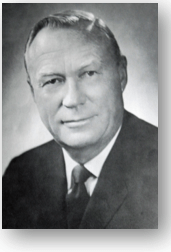Nevada Aerospace Hall of Fame
Declaration of Enshrinement
November 7, 2012
Newton H. Crumley
Newton H. (Newt) Crumley, born February 3, 1911, in Tonopah Nevada, entered the University of Nevada at the age of sixteen and received a Bachelor of Arts degree in Mathematics degree. He served with the 27th Squadron, 1st Pursuit Group, at Selfridge Field Maine. In February 1934, he began flying the US Mail until honorably discharged on August 8, 1934, where he continued to serve as a lieutenant in the Reserves.
In July 1941, now-Captain Crumley returned to active duty as the commander of the Tenth Air Base Squadron at Moffat Field, California. He advanced in rank and in March 1944, assuming command of Minter Field, California, the largest training field of its type on the west coast and earned promotion to full colonel.
Crumley left active duty at the end of the war, but he continued to serve in the Air Force Reserve where he became deputy wing commander of the 92nd Bomb Wing at Castle Air Force Base in California. He was also active in the Nevada Wing of the Civil Air Patrol where he became wing commander in November 1953.
The winter of 1952 had a major impact on Northern Nevada with ranches snowed in, unable to feed cattle in the tens of thousands and sheep in the hundreds of thousands, all stranded in snowdrifts, unable to reach feed. President Truman had declared Elko County and five other Nevada counties disaster areas and the Federal government mounted efforts to grade roads and transport hay to the rural areas of the West. After a storm in late March Crumbly, serving as an emergency director for Elko County, flew over northern Elko County where he saw cattle too weak to survive long enough to benefit from feed delivered via land routes. The decision was made to drop hay to livestock by the use of Fourth Air Force planes from Hamilton Field, California. “Operation Haylift” began March 23rd and Crumley coordinated all flights associated with the operations to include interactions between the Air Force, emergency management personnel, and local ranchers. By the 27th, operations had expanded to include Navy aircraft. On March 28th alone, aircraft completed a total of twelve flights and dropped an estimated 50 tons of hay to starving livestock in a single day. The operation brought relief to an estimated 200,000 starving cattle and about 400,000 sheep, all starving in outlying areas with access roads clogged by deep snow.”
On February 10, 1962, Crumley was flying his twin-engine Aero Commander from Palm Springs California to Elko when he ran into freezing rain and heavy icing north of Tonopah. In his last transmission, he indicated that he was descending and was going to attempt to return to the Tonopah airport. No further transmissions were received. The airplane was found the next day with no survivors on board.
For his support of aviation in Nevada, and specifically for his role in Operation Haylift during the winter of 1954, Newton H. Crumley earned his place in the Nevada Aerospace Hall of Fame.
___________________________________
TD BARNES, Executive Director
Nevada Aerospace Hall of Fame
![]()
